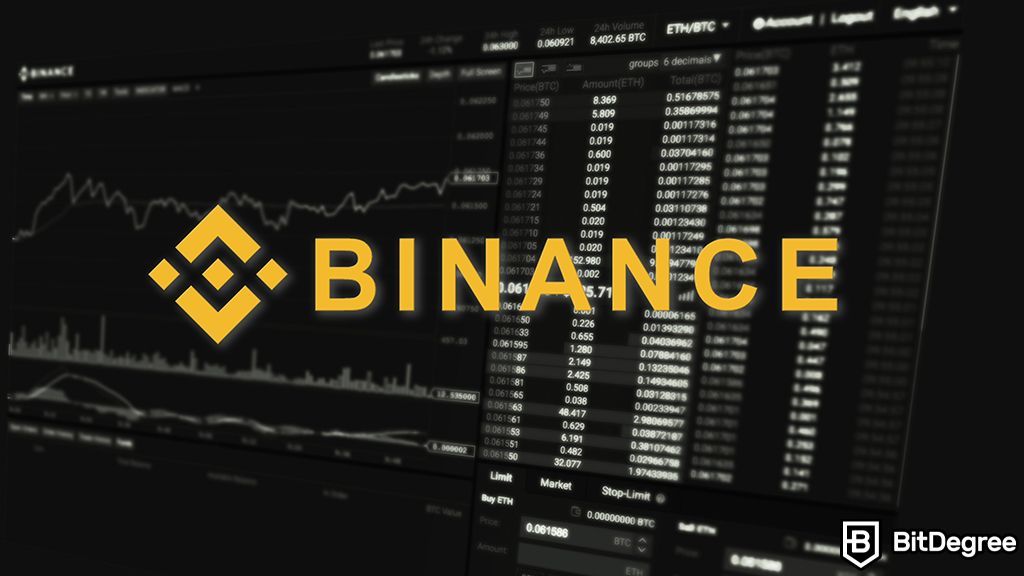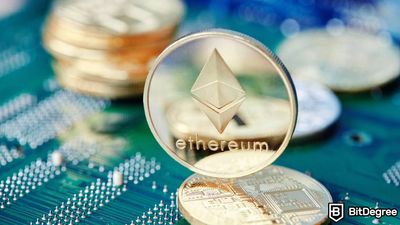Key Takeaways
- The Binance spot trading market has more than 1,500 trading pairs and allows immediate buying and selling of over 600 cryptocurrencies;
- There are several order types in the Binance spot trading market, including market, limit, stop-limit, OCO, and trailing stop orders;
- The standard Binance spot fee is 0.1%. However, you can lower it by increasing your Binance VIP level, while some trading pairs are fee-free overall.
Stop overpaying - start transferring money with Ogvio. Sign up, invite friends & grab Rewards now! 🎁
Venturing into the dynamic realm of cryptocurrency trading? Chances are you've come across the buzz surrounding "spot trading," a widely embraced method in this fast-paced landscape. Being one of the top players in the crypto exchange industry, the Binance spot trading market commands the spotlight in this field.
After all, as of writing, Binance ranks as the most popular CEX based on trading volume, which goes over $6 billion.
So, buckle up and let's navigate the wild terrain of Binance spot trading together, where fortunes are made, memes are born, and the market never sleeps.

Did you know?
Subscribe - We publish new crypto explainer videos every week!
What is a Crypto Bull Run? (Animated Explainer + Prediction)


Table of Contents
- 1. What is Binance Spot Trading?
- 1.1. Spot Trading Order Types
- 1.2. Binance Spot Trading Fees
- 2. How to Spot Trade on Binance?
- 2.1. How to Spot Trade on the Binance Website?
- 2.2. How to Spot Trade on the Binance App?
- 3. Binance Spot Wallet: Understanding and Navigating It
- 3.1. How to Deposit Funds into the Binance Spot Wallet?
- 3.2. How to Withdraw Funds from the Binance Spot Wallet?
- 4. Spot Trading Tools: Trade Analysis and Average Cost
- 4.1. How to Use Trade Analysis?
- 4.2. How to Use Average Cost?
- 5. Benefits and Risks of Spot Trading
- 6. Conclusions
What is Binance Spot Trading?
So, what is Binance spot trading, exactly? Well, imagine walking into a bustling marketplace where you can buy and sell various goods in real time. Binance spot market is very similar to that, apart from the fact that it's digital and the "goods" you can buy or sell are cryptocurrencies.
Latest Deal Active Right Now:As one of the leading cryptocurrency exchanges, Binance offers an extensive range of over 600 digital assets. The roster includes familiar names such as Bitcoin (BTC), Ethereum (ETH), and Ripple (XRP), among many others. It also supports various fiat currencies, including USD, EUR, TRY, and so on, allowing both crypto-crypto and crypto-fiat spot trading.
Overall, the platform offers over 1,500 fiat and spot Binance trading pairs, allowing you to seamlessly exchange one cryptocurrency for another.

Now, how does spot trading itself work?
Put simply, spot trading involves the immediate exchange of assets at the current market price. Unlike futures or options trading, where the actual exchange happens at a future date, spot trading transactions are settled "on the spot," usually within a short time frame. Thus, you’re dealing with the actual assets themselves, not speculating on their price movements[1].
Trading pairs play a crucial role in this process. A trading pair consists of two different types of assets: one that you are selling and one that you are buying. For example, if you have Bitcoin and want to acquire Ethereum, you would use the BTC/ETH trading pair. The first currency (in this case, BTC) is called the "base currency," while the second one (ETH) is the "quote currency."
Though, the most important part of a spot market is the order book, which essentially is a real-time, continually updated list of buy and sell orders in particular trading pairs. Speaking of orders, do note that there are various order types you can make when trading, but I'll talk about them a bit later.

It's also worth noting that spot trading mainly falls into two categories: exchange-based spot trading and Over-the-Counter (OTC) trading. In exchange-based spot trading, an exchange acts as an intermediary that connects buyers and sellers, enabling trades at current market rates.
OTC trading, on the other hand, is a direct deal between two entities. The latter offers more flexibility in terms of price and volume and is mostly used for making sizable trades.
In this article, I'll focus on the Binance spot trading market. However, if you’re interested, don’t forget to check out its OTC trading desk as well.
Anyway, here you have the answer to the question, “What is spot trading on Binance?” Now, let’s talk about the types of orders that can take place on the Binance spot market order book.
Spot Trading Order Types
As you gear up to dive into Binance spot trading, it's essential to understand the different order types this platform offers and how they work. The reason for their importance is simple – the order you choose should be in tune with your trading strategies, so your chances of success spike up.
Market Order
Firstly, there's the market order. This type of order enables you to buy or sell a cryptocurrency instantly at its current market price. Since the order is completed immediately, it doesn’t go to the order book.
Thus, a market order is a swift and efficient way to act promptly when timing is of the essence. When pondering the question, "What is spot trading on Binance?", the market order should be the first thing that comes to mind.
Limit Order
Limit order, on the other hand, empowers you with greater control. With this order type, you set a specific price at which you're willing to buy or sell. Once the market reaches your designated price, your order gets executed.
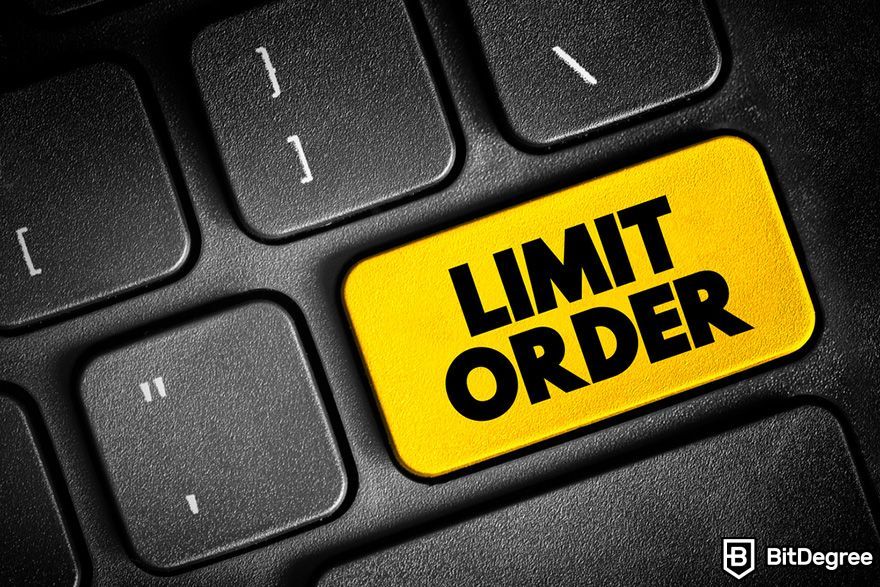
This method gives you a degree of influence over the price you pay or receive. Although, keep in mind that your order might not be filled if the market doesn't reach your specified price.
Stop-Limit Order
When it comes to stop-limit orders, you get to set a specific price at which you want to buy or sell a cryptocurrency (just like with a limit order) and, once the trigger price is reached, the order will be placed automatically.
But here's the kicker – you also get to establish a stop price, meaning you get to decide the smallest profit that satisfies you or the most money you're ready to use or lose in a trade.
One Cancels the Other (OCO) Order
The OCO order is a handy tool when you're not sure which way the market might swing. Imagine placing two orders at the same time, and when one of them is executed, the other is automatically canceled. But, what’s the point of this order?
Let's say you're waiting to buy a cryptocurrency at a lower price, but you're also ready to sell if the price goes higher than expected. With an OCO order, whichever condition is met first triggers the corresponding action, and the other order bows out. It's like having a backup plan that kicks in when you need it.
Trailing Stop Order
A trailing stop order is a bit like a stop-limit order, but it's got a twist. Imagine you're in a race – when things go well, you keep going, and when things go wrong, you stop. That's what a trailing stop order does for your trades.

Essentially, you set a distance from the current price, and if the market goes in your favor, this distance follows, keeping your profits secure. But, if the market suddenly goes the other way by a certain percentage, the order switches to a limit order and closes the trade. It's all about locking in those profits and minimizing losses.
Binance Spot Trading Fees
Now that you know all about these orders, let's talk about the costs of spot trading. The specifics of the Binance spot trading fees can vary, depending on factors such as the trading pair in question, your trading volume, and whether you hold Binance Coins (BNB) in your Spot Wallet or not.
Besides, the fees also depend on whether you are a market maker or a market taker. The former is when you place an order that goes to the order book (such as a limit order, for example) and, therefore, provides liquidity (or volume) to the market. The latter, as the name suggests, “takes” liquidity or volume by fulfilling the order before it even goes to the order book.
Talking about Binance spot trading, there's this cool thing called the VIP program, which plays an essential role in Binance spot fees. It's like a ladder, divided into different levels. As mentioned before, your position on this ladder is determined by how many Binance Coins you hold and / or how much you trade each month.

If your monthly trade volume is below 1,000,000 BUSD or your BNB balance is zero, the Binance spot trading fee will be 0.1% for both makers and takers. This is the only tier where the maker and taker percentages match. Thus, it’s the standard Binance spot fee.
However, if you want an even better deal, you can use BNB to pay your transaction cost and get a 25% discount, reducing the standard maker / taker fee from 0.1% to 0.075%.
Now, moving up the ladder, for those with a monthly trade volume of 1,000,000 BUSD (or more) and a BNB balance of at least 25, fees drop to 0.09% for makers and remain at 0.1% for takers. Again, if you use BNB to pay, these fees will be decreased by 25%. This marks the first VIP level and goes on until you reach the final (9th) level.
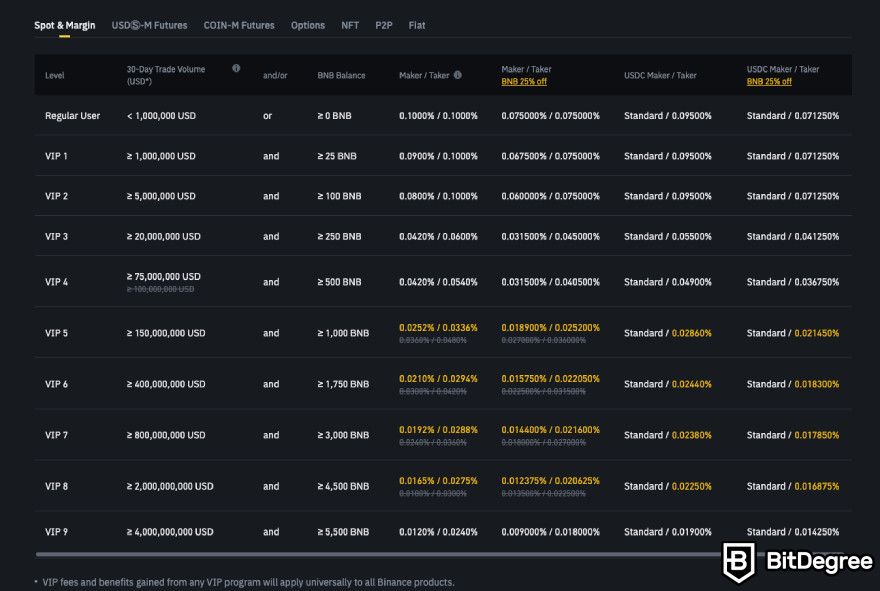
So, increasing your monthly trading volume and maintaining a higher BNB balance advances you to a superior VIP level, yielding reduced Binance spot fees. Besides, directly using BNB to pay for your transaction costs gives you a discount.
However, remember I've mentioned that Binance spot fees can also change based on the trading pair in question? Well, for most trading pairs, like BNB/BUSD, BTC/AUD, BTC/USDT, and many others, the standard fees for makers and takers follow the VIP level system.
Anyhow, there are also a few pairs that don't follow this system, including the BTC/TUSD pair that charges zero fees, as well as BNB/TUSD and ETH/TUSD pairs that don’t charge any fees from makers, but do charge taker fees. Thus, if you're looking for fee-free spot trading, you can find it on Binance, too.
Now that you know what is spot trading on Binance and understand its fee structure, it’s time to dive into the next question: How to spot trade on Binance?
How to Spot Trade on Binance?
When it comes to Binance spot trading, you've got a couple of paths to choose from: you can do it on the website through your browser or dive into the experience through the mobile app.
Note that your account needs to be verified in order to access Binance’s services. So, make sure to do the verification process. Also, you need to have funds in your Binance spot wallet. Don't fret, if you're unsure about wallet management, I’ve included a tutorial further in this guide, too.
How to Spot Trade on the Binance Website?
Let's first explore the spot trading process on your browser.
Step 1: Log in to your Binance account; if you're new, take a moment to create one. If you've ever signed up on any website, I'm sure you'll be fine – Binance's registration process is pretty self-explanatory. Once you're in, head to the "Trade" tab at the top and select "Spot."

Step 2: By default, you'll be taken to the Binance spot trading interface featuring the BTC/USDT trading pair. It might seem a little overwhelming due to the amount of visual information. But don't worry, it's actually not that complicated.

On the first half of the page, you'll see all the necessary information about the trading pair in question, including price charts, sell orders, and so on. You'll also see a window where you can pick another trading pair, as well as spot trades that already happened.
When you scroll down, you'll see buy orders, order making dashboard, and some personal information like your open orders, order and trade history, and funds. Besides, notice that at the top of the order making dashboard, you can pick between spot, cross, isolated and grid options.
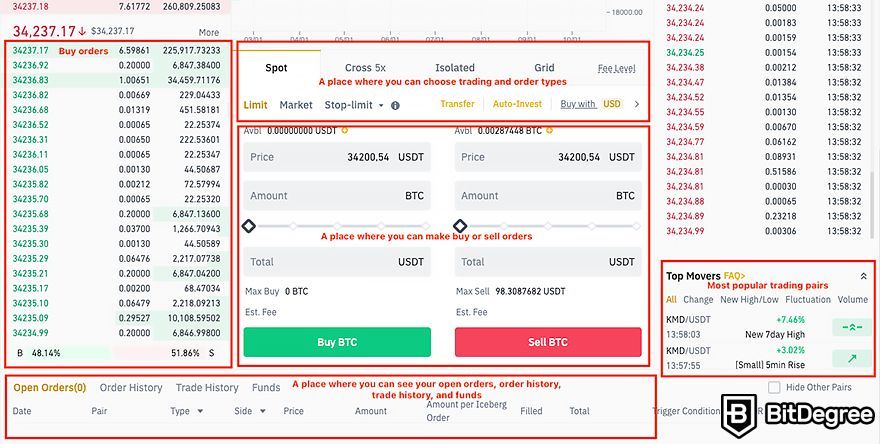
Cross and margin trading options are for those interested in margin trading, but this is another topic. Grid option, on the other hand, is designed to automate the buying and selling of crypto by setting predetermined price levels. It's a nod to traders who prefer automated strategies, but without the complexity of setting up trading bots.
Step 3: Once you familiarize yourself with the interface, you can pick the trading pair you want to trade. Let’s say you have ETH, but you want to get BTC – then, you should pick the ETH/BTC trading pair.
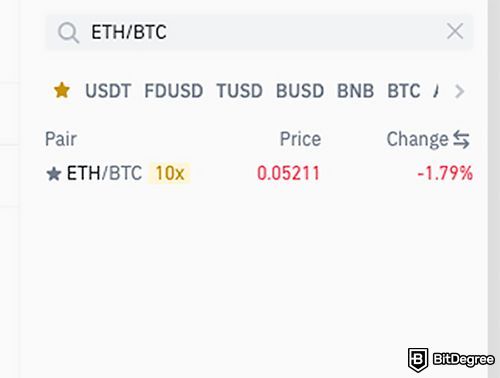
Step 4: If you're buying, it's a "Buy" order, and if you're selling, it's a "Sell" order (obviously). So, in this case, you would go with the sell order (selling ETH and buying BTC).
Now, you need to choose your order type. Remember, you can pick between limit, market, stop-limit, trailing stop, and OCO. However, for your first trade, I'd suggest simply going with the market order.
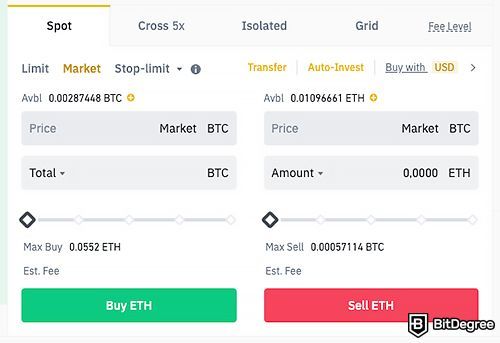
Step 5: Enter the amount you want to trade. Notice that below the “Amount” box, there is a bar. It allows you to choose the percentage of your Binance spot wallet balance you wish to use for the order. So, you can either type in the amount by hand or choose it using this bar.
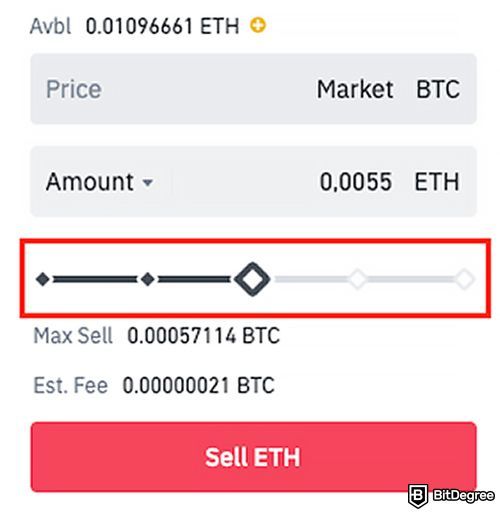
Eventually, double-check your order details and click the "Buy" or "Sell" button.
That's it! Mastering spot trading on the Binance website via browser lays a strong foundation for your cryptocurrency trading endeavors. With these insights in hand, you're poised to navigate the dynamic world of spot trading with clarity and precision.
How to Spot Trade on the Binance App?
Now, if you want to embrace the convenience of mobile trading, here is a guide on spot trading on the Binance app.
Step 1: Open the Binance app and log in. If you're new, create an account.
Step 2: Tap on the "Trade" icon at the bottom. By default, you should be taken to the spot trading interface.
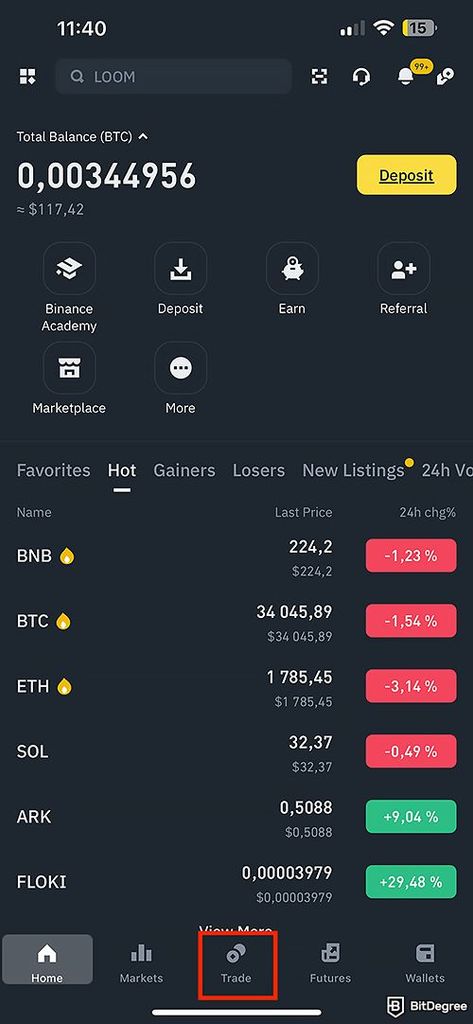
Step 3: Select the cryptocurrency pair you want to trade and decide whether you'll be buying or selling. Also, select the order type.
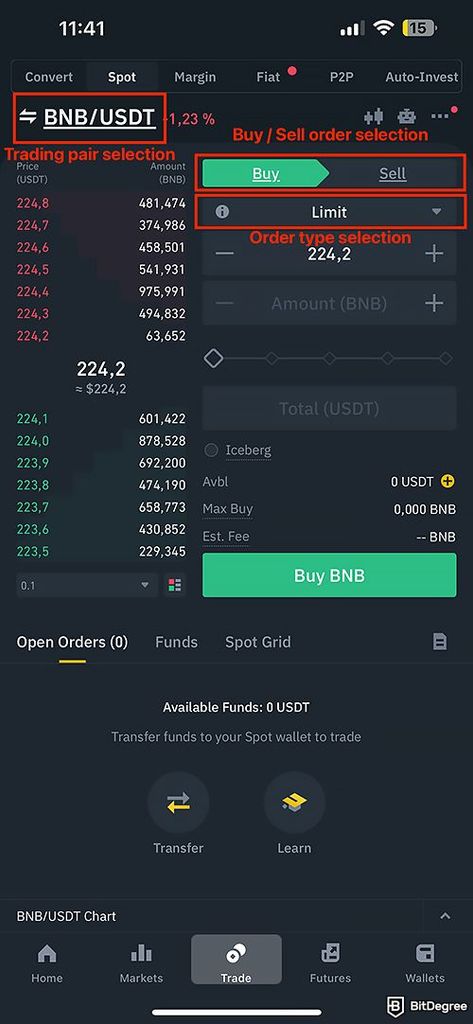
Step 4: Input the amount. You can type it in by hand or use the percentage bar below the amount box.
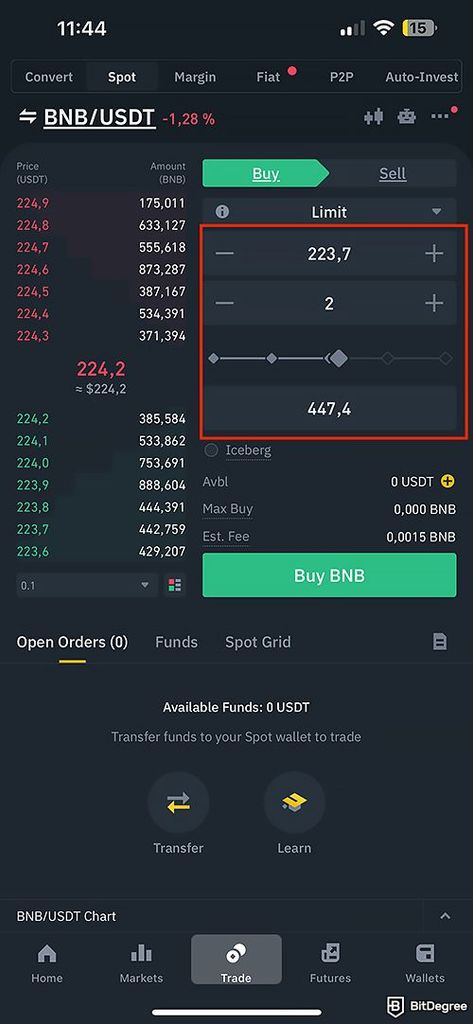
Step 5: Once you’ve added all the order details, click "Buy / Sell X" and then “Confirm”. You'll see your order in the “Open Orders” section at the bottom.
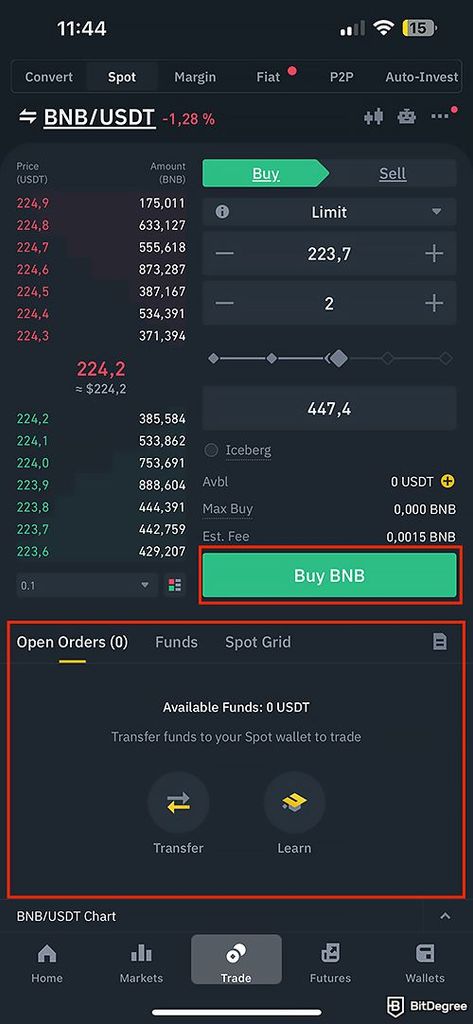
There you have it – step-by-step guides to spot trading on Binance using both, the browser and the app. Now, let’s go over your Binance spot wallet management
Binance Spot Wallet: Understanding and Navigating It
As you might already guess, a spot wallet works as your digital pocket within the Binance spot trading platform. It's where you store your cryptocurrencies for trading purposes.
So, let's look deeper into the intricacies of the Binance spot wallet.

Did you know?
Subscribe - We publish new crypto explainer videos every week!
How to Pick the Right NFTs? (Animated DOs & DON'Ts)
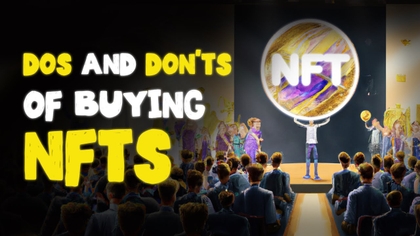

How to Deposit Funds into the Binance Spot Wallet?
Fueling your trading journey begins with funding your Binance spot wallet.
Step 1: Hover your mouse over the wallet icon and click on "Fiat and Spot” on Binance’s interface.

Step 2: Once there, click on "Deposit."

Step 3: Then, you’ll be given two options – to deposit cryptocurrency or fiat.
Deposit Fiat:
If you want to deposit fiat, you just have to select the coin you desire, the payment method, and click “Continue.”
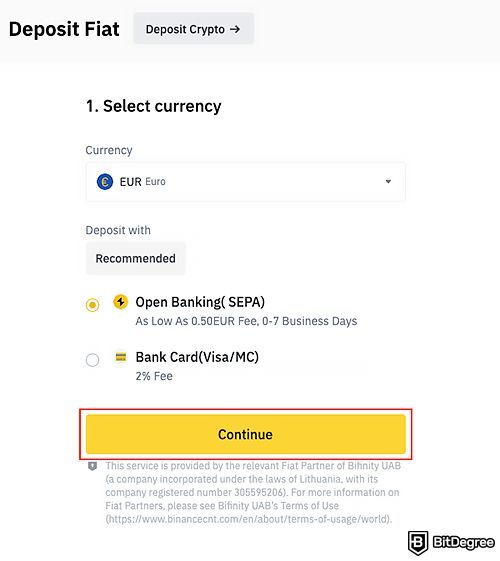
Then, fill in your payment account details, enter the amount you want to deposit and click "Continue" once more. Do note, though, that there is a minimum deposit amount set, so you cannot deposit $1 or €1, for example.
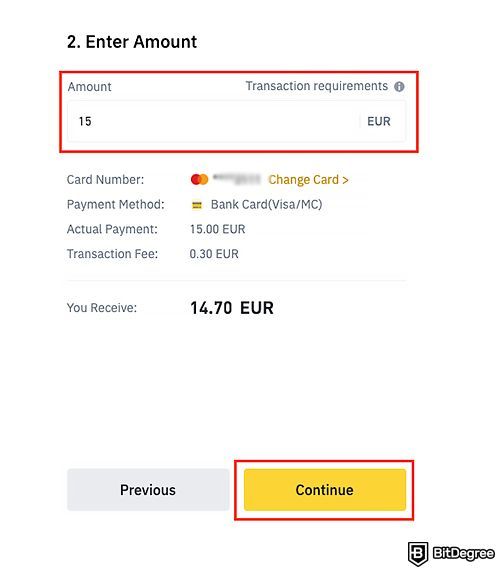
Confirm your payment and wait for it to be registered on Binance.
Deposit Crypto:
If you already own crypto and want to deposit it from some other wallet, click on the "Deposit Crypto" button. You'll be taken to a page where you'll have to pick the coin you want to deposit and the network through which the deposit will be made - for example, BNB; BNB Smart Chain (BEP20).
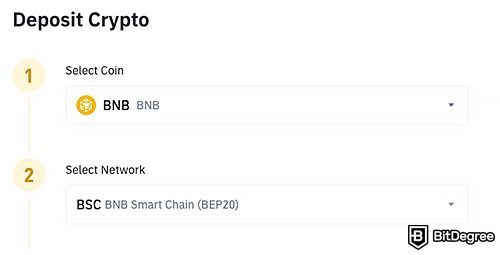
Then, you will be provided with a deposit address. Copy it and head to your external wallet or exchange where you hold your funds. Once you are there, use the copied deposit address to send the desired amount. Though, you can also scan the QR code. Binance will then process your deposit.
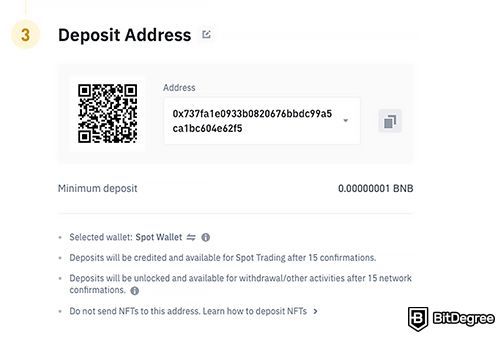
All in all, Binance offers a seamless experience for both fiat and spot Binance transactions, allowing users to easily convert their traditional currencies into cryptocurrencies.
How to Withdraw Funds from the Binance Spot Wallet?
When you're ready to take funds out of your Binance spot wallet, here’s what you need to do:
Step 1: Just like with deposits, go to the "Fiat and Spot" tab, but this time click on "Withdraw."
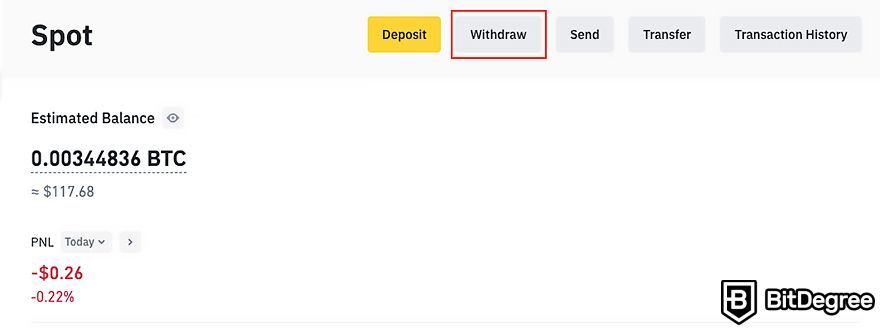
Step 2: Again, you'll be given two options: to withdraw cryptocurrency or fiat currency. The process for each is very similar to depositing.
Withdraw Crypto:
By default, you'll be on the crypto withdrawal page. Here, you'll need to select the coin you want to withdraw and the network you'll use. Then, paste the address of your wallet to which you want to withdraw it or click on the book icon to select a saved address (if you have one).
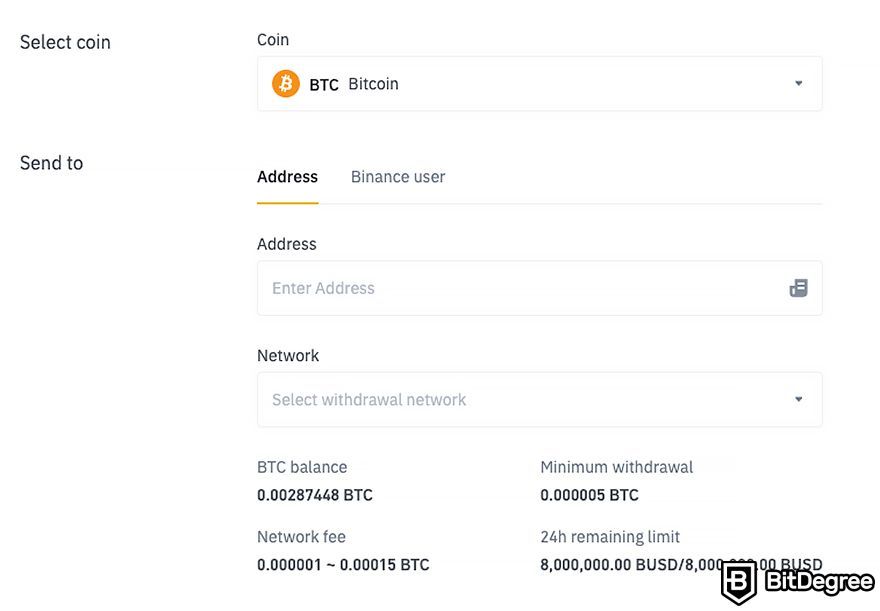
Following that, enter the amount from your spot wallet (do note that there will be a transaction fee), click “Withdraw” and then “Confirm.” After you pass 2FA verification, you’ll be done!
Withdraw Fiat Currency:
Click on “Withdraw Fiat” and choose the coin and the payment method. Next, enter the amount and confirm.
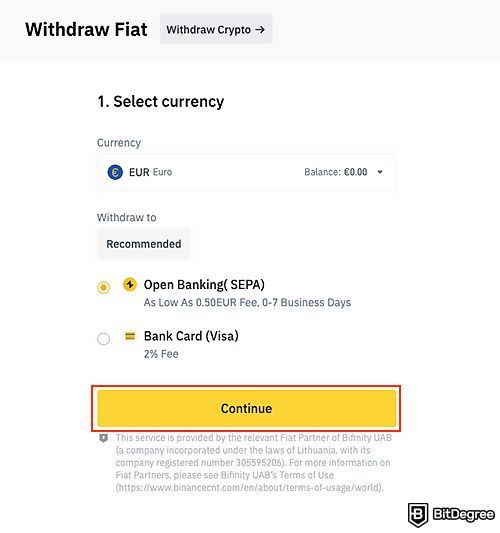
Then, you will have to complete 2FA and click “Submit.” After that, just wait for the completion of the transaction.
Spot Trading Tools: Trade Analysis and Average Cost
When it comes to Binance spot trading, there are two powerful tools at your disposal: Trade Analysis and Average Cost. These functions provide valuable insights to enhance your trading decisions and strategies.
I’ve assembled two tutorials in case you are interested in using these mechanics. But, before diving into them, here are some things to have in mind:
Trade Analysis is a built-in analytical tool aimed at enabling users to better understand their trading habits and performance. However, it only includes data for buy and sell orders within a chosen time frame, excluding other transaction types like deposits and withdrawals. Besides, it doesn't show if your position is negative, and it’s not a reflection of your spot account’s current balance.
Trade analysis essentially provides insights like last position value, sum buy / sell amount, average buy price, realized / unrealized PNL, and so on. Though, note that the system can't display data if your buy volume is lower than the sell volume in the chosen period.

The Average Cost function, on the other hand, is a feature designed to help traders keep track of their investment costs more easily. It calculates the average price at which you bought a specific cryptocurrency, taking into account all your buying transactions for that particular asset.
It then provides an overview of your acquisition cost, allowing you to make more informed decisions on whether to buy more, hold, or sell. The function could be particularly useful for engaging in cost-averaging strategies, as it automates the calculation process that would otherwise be manually intensive.
Keeping that in mind, let's see how to use these tools.
How to Use Trade Analysis?
Let's start with Trade Analysis.
Step 1: Hover your mouse over the icon representing a paper with orders and click on the “Spot Order” button.

Step 2: On the left side of the screen, pick the “Trade History” tab.
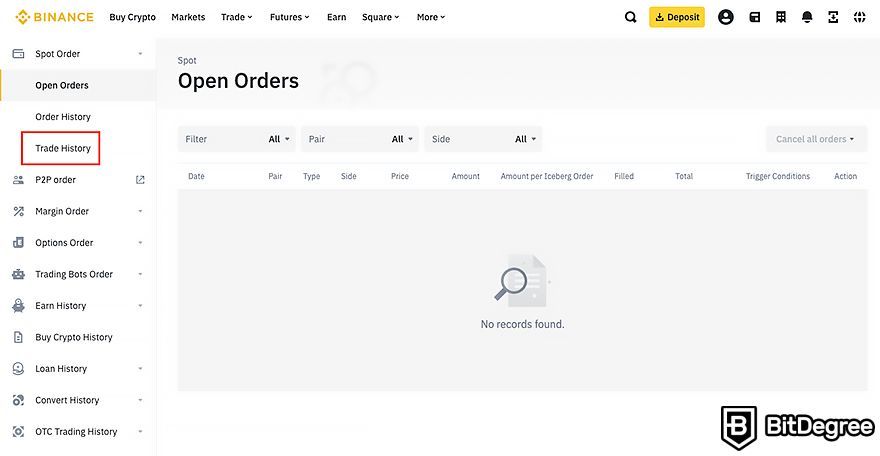
Step 3: Then, click on the “Trade Analysis” button next to the “Export” button at the top right corner of the page.

Step 4: Once the Trade Analysis window shows up, enter the date, base, and quote, click “Search,” and wait for the results.
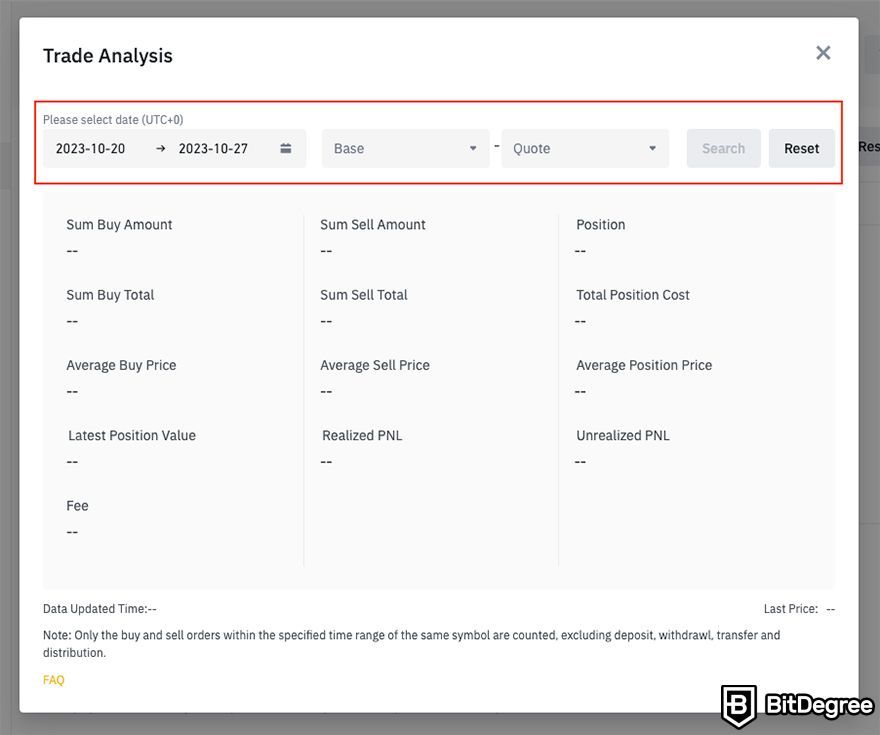
By following these straightforward steps, you can harness the power of Trade Analysis on Binance.

- Secure and reliable
- Accepts fiat currencies
- Lots of trading options
- Reputable exchange
- Accepts fiat currencies
- Offers various trading options

- Huge trading variety
- Regulation-compliant around the globe
- Fair trading fees
- Beginner-friendly
- A wide array of features
- Vast number of different crypto coins & tokens

- Beginner-friendly
- Secure
- Decent trading and withdrawal fees
- Crypto.com Visa Card
- Automated tools & bots
- Ecosystem synergy with CRO
How to Use Average Cost?
Now, using the Average Cost function only takes a few steps.
Step 1: On the main page, pick the “Spot” option on the “Trade” tab.

Step 2: Find the “Display Settings,” which are represented by an icon that depicts a piece of paper with a list. Hover your mouse over it and then turn on the “Average Cost” option.
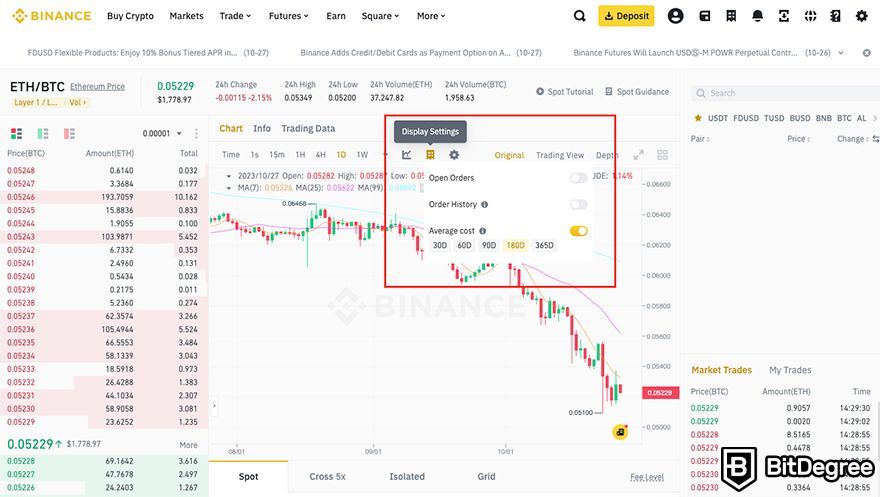
Once you do that, your average buy price will be indicated by a floating line on the price chart.
Okay, now that we have gone over all of the main operations related to Binance spot trading, let’s explore the array of benefits and potential risks that spot trading presents overall.
Benefits and Risks of Spot Trading
I'll first talk about the good stuff that comes out of Binance spot trading and then go over the less positive side.
Benefits:
- Ownership Assurance. When you buy a cryptocurrency through spot trading, you actually own it. This provides a tangible sense of ownership and control over your assets.
- Simplicity and Transparency. Spot trading is relatively straightforward. You see the current price, make a decision to buy or sell, and execute the trade.
- Flexibility and Long-term Holding. With spot trading, you can hold onto your coins for as long as you want. You're not under pressure to sell quickly or meet certain deadlines. It's your call when to buy and when to sell.
- Less Prone to Manipulation. Spot markets are generally considered to be less susceptible to market manipulation compared to derivative markets.
Risks:
- Market Volatility. Crypto markets are notorious for their price volatility. Prices can go up, down, and sideways faster than you can blink. So, while your investments might double in value, they could drop suddenly as well - it truly is not for the faint of heart.
- Lack of Regulation. The cryptocurrency market operates with less strict regulatory oversight, exposing traders to higher levels of risk compared to traditional financial markets.
- Security Concerns. While Binance is a reputable platform, crypto still is a digital technology, meaning it's subject to cyber attacks[2]. Thus, it's crucial to protect your account, use strong passwords, and enable advanced security features like two-factor authentication.
- Operational Risks. Issues such as system failures, technical glitches, or disruptions in trading platforms can disrupt trading activities and even result in financial losses.
In a nutshell, spot trading can be your ticket to the world of cryptocurrencies and potential gains, but, like any adventure, it comes with its highs and lows. The key is to do your research, have a strategy, and avoid putting all your eggs in one basket.
Conclusions
So, now that you've picked up the know-how about spot markets, managing your spot wallet, and understanding Binance spot trading fees, you're set to jump into the thrilling realm of cryptocurrency trading.
But, as we wrap up, remember this: Binance spot trading is a mix of chances and challenges, as it is with any other exchange. Yes, you can make some great gains, but the cryptocurrency market can be quite unpredictable. It's smart to do your homework, be ready for ups and downs, and make choices that fit your plan.
Therefore, as you step into the world of Binance spot trading, keep learning, keep an eye on the risks, and keep your goals in mind. Good luck and happy trading!
The content published on this website is not aimed to give any kind of financial, investment, trading, or any other form of advice. BitDegree.org does not endorse or suggest you to buy, sell or hold any kind of cryptocurrency. Before making financial investment decisions, do consult your financial advisor.
Scientific References
1. J. Zhang, K. Robertson: ‘Suitable Price Discovery Measurement of Bitcoin Spot and Futures Markets’;
2. F. Fang, C. Ventre, M. Basios, et. al.: ‘Cryptocurrency Trading: A Comprehensive Survey’.
